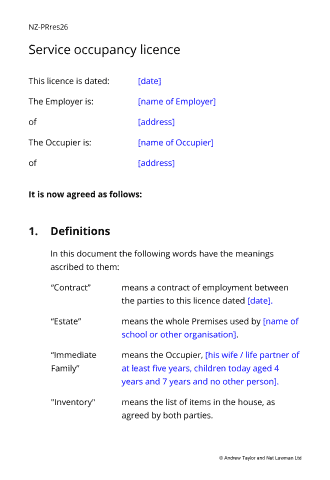Service occupancy agreement

Document overview


- Length:7 pages (1850 words)
- Available in:
 Microsoft Word DOCX
Microsoft Word DOCX Apple Pages
Apple Pages RTF
RTF

If the document isn’t right for your circumstances for any reason, just tell us and we’ll refund you in full immediately.

We avoid legal terminology unless necessary. Plain English makes our documents easy to understand, easy to edit and more likely to be accepted.

You don’t need legal knowledge to use our documents. We explain what to edit and how in the guidance notes included at the end of the document.

Email us with questions about editing your document. Use our Lawyer Assist service if you’d like our legal team to check your document will do as you intend.

Our documents comply with the latest relevant law. Our lawyers regularly review how new law affects each document in our library.
About this service occupancy agreement
Certain types of employment often provide accommodation as part of the remuneration package. Such accommodation is called “service occupancy” or sometimes “tied accommodation”. In law, it is either a residential licence with terms tied to the employment contract or a lease agreement.
This service occupancy agreement creates a licence. It provides for the full protection of the employer-licensor.
The advantage of creating a residential licence is simple: with a service occupancy agreement, the right to occupy terminates when the employment ends; however, if you let property under a tenancy agreement instead, then you may find it difficult to end the tenancy and obtain vacant possession when employment ends.
This service occupancy agreement enables you to obtain possession when the employment ends.
The law relating to this service occupancy agreement
The default status of an arrangement whereby you provide accommodation for an employee is that he is your tenant under tenancy agreement.
If you do not have a written tenancy agreement, you don’t have control over property (even after his employment ends). So, if you want to retain control of your property, you have to use either a formal tenancy agreement or arrange the deal in such a way that it really is a service occupancy agreement.
Just using an agreement with that title is a non-starter. To “qualify” as service occupancy, the deal must be:
- You receive no rent
- The occupancy is reasonably necessary to the employee performing his duties adequately
- The contract of employment specifies that he must occupy this accommodation
- The terms above have not changed at the time the law is applied.
If you think your deal may not qualify, buy a lease agreement. If it does qualify, then you can easily edit this document to be perfect for what you need.
The template allows you to comply with the Residential Tenancies Act 1986.
When to use this agreement
Types of employment that might require the employee to live in a specific place designated by the employer include:
- Live-in nanny, house keeper or carer;
- Hotel staff;
- Security staff;
- Care takers;
- Grounds and estate staff;
- Teachers at boarding schools.
This agreement is very flexible and can cover a business in any industry or where the employer is an individual. The type of accommodation is not important, and could range from a bedroom to a whole detached property.
Service occupancy agreement features and contents
- Includes sensible, practical provisions to protect the landlord’s interests.
- Full description of the property and the services that the employee should expect to receive in residence.
- A ‘menu’ of nearly 50 provisions determining what employer may or may not allow the employee to do in the property.
- Rent period and amount.
- Provision for the occupier’s rights and restrictions when the property occupied is part of a large complex such as a school or industrial buildings.
Provision has also been made for the employer to move the employee to different accommodation if required or to terminate the licence if the requirements of the job change so that living close is no longer required.
Extra to the document is a draft paragraph which can be added to any contract of employment to confirm the proposed arrangement for service occupancy. Use that too, to make sure there is no doubt as to the status of the arrangement.

Recent reviews
clear guidelines, at a reasonable price.
Well done
Choose the level of support you need
Document Only
This document
Detailed guidance notes explaining how to edit each paragraph
Lawyer Assist
This document
Detailed guidance notes explaining how to edit each paragraph
Unlimited email support - ask our legal team any question related to completing the document
- Review of your edited document by our legal team including:
- reporting on whether your changes comply with the law
- answering your questions about how to word a new clause or achieve an outcome
- checking that your use of defined terms is correct and consistent
- correcting spelling mistakes
- reformatting the document ready to sign
All rights reserved
